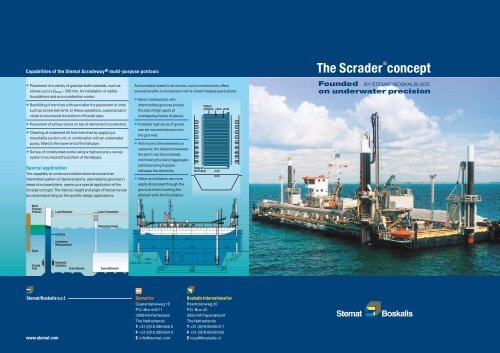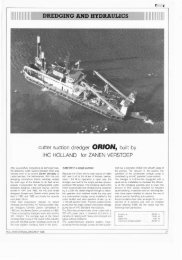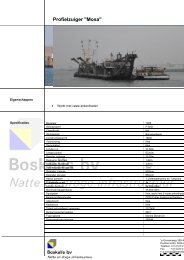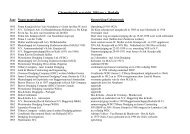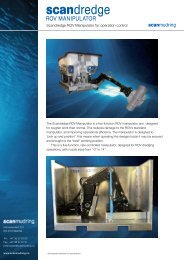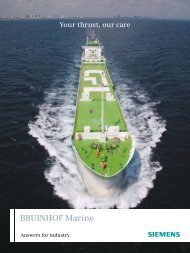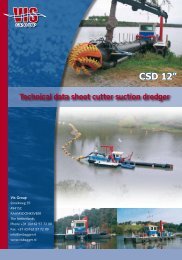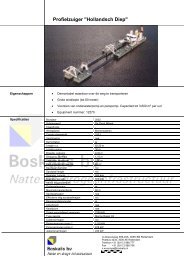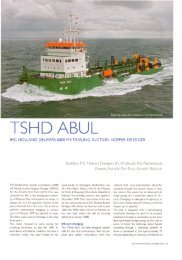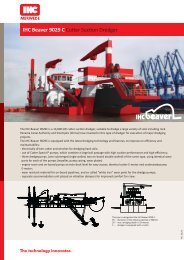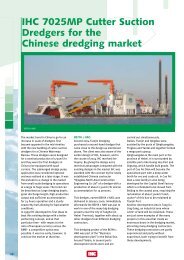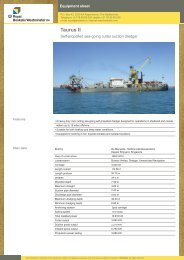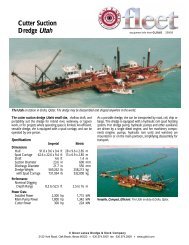The Scrader concept - Dredgepoint
The Scrader concept - Dredgepoint
The Scrader concept - Dredgepoint
Create successful ePaper yourself
Turn your PDF publications into a flip-book with our unique Google optimized e-Paper software.
Capabilities of the Stemat Scradeway ® multi-purpose pontoon:<br />
®<br />
<strong>The</strong> <strong>Scrader</strong> <strong>concept</strong><br />
• Placement of a variety of granular bulk materials, such as<br />
stones up to a D max ≈ 300 mm, for installation of rubble<br />
foundations and scour protection works;<br />
• Backfilling of trenches with sand after the placement of units<br />
such as tunnel elements. In these operations, a special sand<br />
chute is mounted at the bottom of the fall pipe;<br />
As foundation base for structures, such a construction offers<br />
several benefits in comparison with a closed integral gravel plane:<br />
• Berm construction with<br />
intermediate grooves avoids<br />
the risk of high spots at<br />
overlapping tracks of gravel;<br />
Pattern<br />
of Gravel<br />
1.65 m 1.00 m<br />
Founded BY STEMAT/BOSKALIS V.O.F.<br />
on underwater precision<br />
• Placement of armour stone on top of elements for protection;<br />
• Cleaning of undesired silt from trenches by applying a<br />
mountable suction unit, in combination with an underwater<br />
pump, fitted to the lower end of the fall pipe;<br />
• Survey of constructed works using a high accuracy survey<br />
system mounted at the bottom of the fallpipe.<br />
Special application<br />
<strong>The</strong> capability to construct a rubble stone structure of an<br />
intermittent pattern of identical berms, alternated by grooves in<br />
stead of a closed plane, opens up a special application of the<br />
<strong>Scrader</strong> <strong>concept</strong>. <strong>The</strong> interval, height and angle of the berms can<br />
be varied depending on the specific design applications.<br />
• Possible high spots of gravel<br />
can be moved sideways into<br />
the grooves;<br />
• At the joint of the elements or<br />
caissons, the distance between<br />
the berm can be increased,<br />
minimising the risk of aggregate<br />
particles being trapped<br />
between the elements;<br />
• Water and siltation are more<br />
easily dissipated through the<br />
grooves when lowering the<br />
element onto the foundation.<br />
Slope of<br />
the Trench<br />
42 m<br />
56 m<br />
Multi<br />
Purpose<br />
Pontoon<br />
Laser Receiver<br />
Laser Transmitter<br />
Measuring Tower<br />
Spud<br />
Fall Pipe<br />
Inclination<br />
Measurement<br />
Scrade<br />
Foot<br />
Hydraulic<br />
Cylinders<br />
Gravel Berms<br />
Tunnel Element<br />
Stemat/Boskalis v.o.f.<br />
www.stemat.com<br />
Stemat bv<br />
Quarantaineweg 10<br />
P.O. Box 54511<br />
3008 KA Rotterdam<br />
<strong>The</strong> Netherlands<br />
T +31 (0)10 299 655 5<br />
F + 31 (0)10 299 654 3<br />
E info@stemat.com<br />
Boskalis International bv<br />
Rosmolenweg 20<br />
P.O. Box 43<br />
3350 AA Papendrecht<br />
<strong>The</strong> Netherlands<br />
T +31 (0)78 69 69 011<br />
F +31 (0)78 69 69 555<br />
E royal@boskalis.nl<br />
Stemat<br />
Boskalis
Granular bulk material is fed into the fall pipe by a conveyor belt.<br />
<strong>The</strong> <strong>Scrader</strong> <strong>concept</strong> proved<br />
extremely valuable in the<br />
construction of the second<br />
Benelux tunnel across the<br />
port entrance of Rotterdam,<br />
for which the foundation<br />
accuracy requirements were<br />
very stringent.<br />
immersed tunnels, and can be used with a wide variety<br />
of granular bulk materials. It has been successfully<br />
employed in major projects.<br />
With its telescopic fall pipe, the Stemat Scradeway can<br />
operate in water depths of up to 28 metres, laying gravel<br />
foundations with a tolerance of only 25 mm.<br />
Scrading allows for incredible accuracy. In a water depth<br />
of up to 28 metres, the tolerance in laying a gravel<br />
foundation can be less than 25 mm (!). <strong>The</strong> screadhead is<br />
fitted with five multi-transducer echosounders for<br />
continuous survey of the newly 'scraded' layer.<br />
Combining their know-how and equipment in a joint venture, Stemat and Boskalis have set a new<br />
world standard in seabed treatment for underwater construction: the <strong>Scrader</strong> ® <strong>concept</strong>.<br />
Using the specially developed multi-purpose pontoon Stemat Scradeway, the company is capable of<br />
constructing gravel beds with extremely high accuracy in waters up to 28 metres deep.<br />
®<br />
<strong>The</strong> <strong>Scrader</strong> <strong>concept</strong>:<br />
Founded on underwater precision<br />
<strong>The</strong> precision performance of the <strong>Scrader</strong> method allows<br />
for ballasting and placing tunnel elements right onto a final<br />
foundation of gravel, saving time and minimising<br />
construction risks. Besides tunnel projects, the technique<br />
can also be used for other underwater construction works,<br />
such as foundations for bridges, caissons, windmills and<br />
offshore outfalls.<br />
A common technique for building underwater foundations<br />
is known as 'grading', a two step operation of depositing<br />
and subsequent levelling of a gravel bed. Scrading<br />
combines these two operations: the Stemat Scradeway is<br />
equipped with a telescopic fall pipe to deposit and level<br />
the material at the same time. <strong>The</strong> fall pipe is positioned at<br />
the side of the multi-purpose pontoon and can be moved<br />
47 metres, horizontally across the trench. A conveyor belt<br />
on the pontoon feeds the fall pipe with scrade material.<br />
As the fall pipe moves across the trench, it is kept at the<br />
required level by means of a laserguided hydraulic<br />
'screadhead' and remains in constant contact with the<br />
gravel berm. With the vertical flow of the material confined<br />
within the fall pipe, segregation is virtually eliminated, while<br />
substantially less gravel is used.<br />
<strong>The</strong> <strong>Scrader</strong> method is ideal for construction of underwater<br />
foundations for projects such as caisson walls and<br />
Construction of gravel bed foundation for breakwater in<br />
Cartagena, Spain<br />
Reference list executed projects:<br />
Gravel bed for Øresund tunnel<br />
Copenhagen, Denmark<br />
Gravel bed for second Benelux tunnel<br />
Rotterdam, <strong>The</strong> Netherlands<br />
<strong>The</strong> Scrading process is fully<br />
automated. <strong>The</strong> system<br />
operator observes the<br />
process on a computer<br />
monitor, displaying the<br />
underwater actions as well<br />
as the positioning<br />
information.<br />
Bachfilling powercable trench with slacks<br />
Westerschelde, <strong>The</strong> Netherlands<br />
Renewal of roof cover of Elbe tunnel<br />
Hamburg, Germany<br />
Gravel bed for caisson quay wall<br />
Cartagena, Spain


